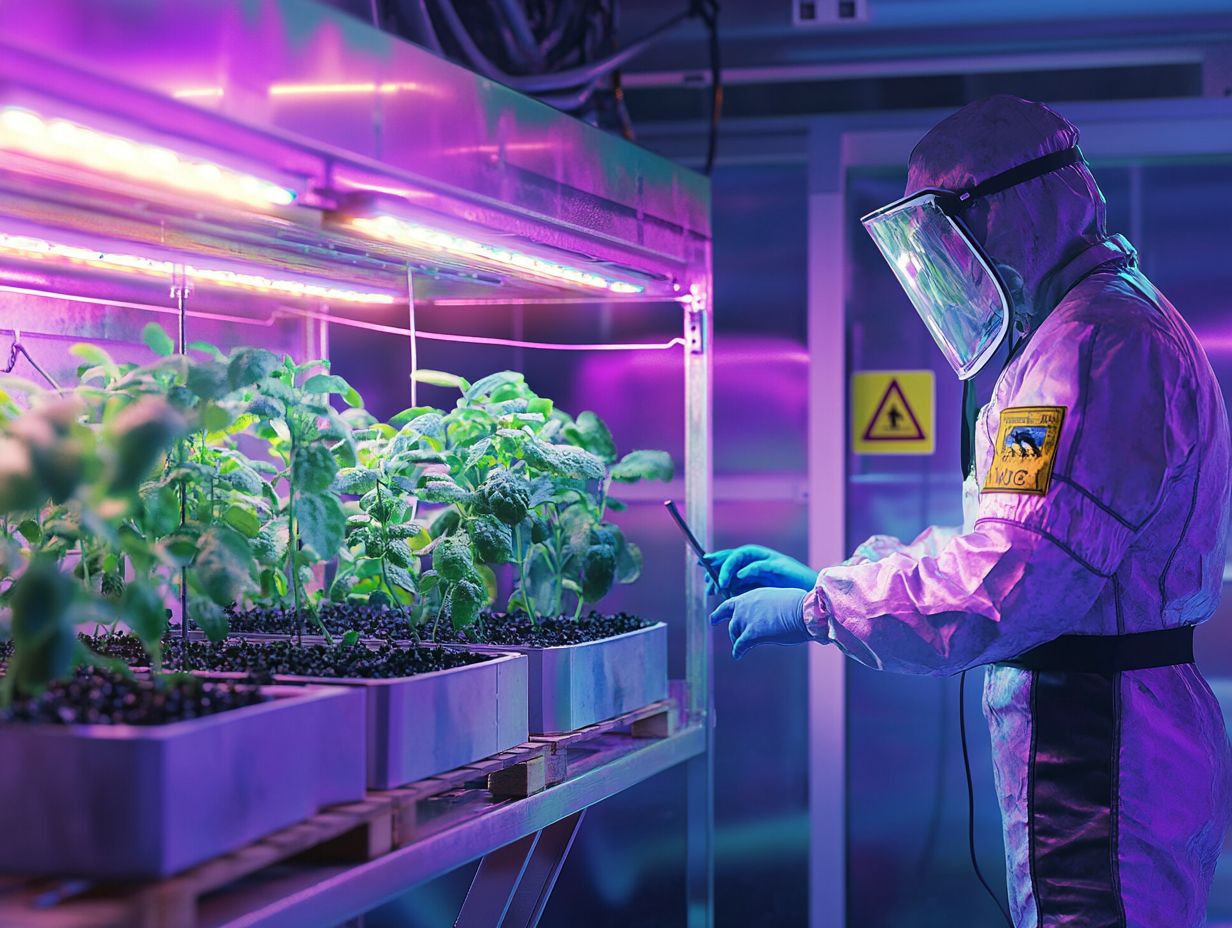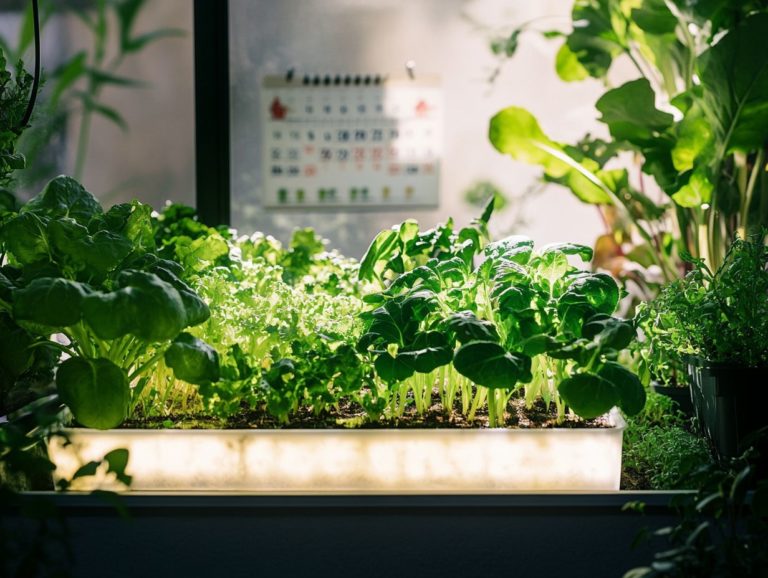What Safety Precautions Are Needed for Hydroponics?
Hydroponics is a groundbreaking way to grow plants without soil. Instead, it uses special water with nutrients to help plants thrive efficiently.
This approach has specific safety considerations you must know. Identifying potential hazards and using protective gear is crucial to ensure your success.
Let s explore essential safety measures that will keep your hydroponic garden thriving! We ll highlight common pitfalls and share best practices for growing healthy, safe produce.
Contents
- Key Takeaways:
- Safety Precautions for Hydroponics
- Common Safety Mistakes to Avoid
- Ensuring Food Safety in Hydroponics
- Frequently Asked Questions
- What Safety Precautions Are Needed for Hydroponics?
- Is hydroponics safe for indoor use?
- Are there any specific safety measures for handling nutrient solutions?
- Do I need to be concerned about mold or bacteria growth in my hydroponic system?
- Can I use pesticides or other chemicals in my hydroponic system?
- Are there any safety concerns with using grow lights in hydroponics?
- What are the risks of using an electrical water pump in a hydroponic system?
Key Takeaways:

- Understand potential hazards like crop diseases and foodborne germs. Take steps to minimize these risks.
- Use proper protective gear and follow cleaning measures. Gloves and goggles can keep you safe.
- Ensure food safety by using clean water and nutrients. Keep an eye out for possible contaminants.
What is Hydroponics?
Hydroponics is an innovative farming practice that allows you to grow plants without soil. It delivers nutrients directly to the roots with special water.
This method optimizes plant growth and lets you control the conditions for your crops. You can ensure the plants get the right balance of nutrients, water, and light.
By adopting hydroponic techniques, you can achieve ecological balance, use less water, and improve production efficiency.
The history of hydroponics goes back to ancient times. The Hanging Gardens of Babylon are often considered one of the first examples of growing plants without soil.
Modern hydroponics began to develop in the 20th century, showcasing its potential for year-round farming. With faster crop growth, you can enjoy multiple harvests each year.
By reducing soil dependency, you face fewer problems with pests and diseases. This leads to cleaner produce and sustainable farming practices.
Safety Precautions for Hydroponics
Safety in hydroponics is key to protecting your produce from contamination and foodborne illnesses. Implement rigorous cleaning routines and provide staff training on sanitation measures.
By following food safety protocols, you can significantly reduce risks while building consumer confidence in your practices.
Understanding Potential Hazards
Understanding the potential hazards in hydroponics requires you to recognize the various risks associated with crop diseases, foodborne pathogens, and environmental conditions that can negatively impact plant health and food safety. Conducting a thorough risk assessment, the process of identifying and analyzing potential issues, through regular water testing ensures that sanitation measures are effectively implemented.
This proactive approach significantly reduces the likelihood of contamination, promoting healthier crop production. Identifying these hazards helps you tackle issues that may arise during hydroponic cultivation before they escalate.
Stay alert to the risks of nutrient imbalances and the growth of harmful algae, which can flourish in the nutrient-rich water typical of hydroponic systems. Implementing routine sanitation measures, such as frequently cleaning equipment and changing water to prevent stagnation, is essential in hydroponic cultivation.
By consistently testing water quality and pH levels, you ll gain a clearer understanding of your system and be empowered to make informed adjustments, ensuring an optimal growing environment. This holistic approach to risk management not only safeguards plant health but also enhances the overall productivity and quality of your harvested produce.
Protective Equipment and Procedures

Utilizing protective equipment and implementing effective procedures are crucial for maintaining hygiene practices in hydroponics. Wearing proper gear, such as gloves and masks, allows you and your team to minimize exposure to harmful pathogens while carrying out sanitation tasks.
By prioritizing staff training on these protective protocols, you can enhance safety and significantly reduce the risk of contamination throughout your operations.
Along with gloves and masks, don t underestimate the importance of protective eyewear and coveralls; they are essential for safeguarding against chemical splashes and microbial exposure. Scheduling regular training sessions ensures that everyone in your greenhouse operation is well-versed in the correct protocols, fostering a culture of safety.
It s vital that your team understands proper handwashing techniques and the necessity of frequently disinfecting tools and surfaces.
By cultivating a comprehensive understanding of these best practices, your hydroponic operations can vastly improve hygiene standards, leading to healthier plants and higher quality yields.
Common Safety Mistakes to Avoid
Avoiding common safety mistakes is crucial for you to maintain the integrity of your hydroponic produce and ensure compliance with food safety protocols. Neglecting proper pest management, failing to monitor environmental conditions, and not sticking to established cleaning schedules can lead to contamination, jeopardizing the health of your crops.
By recognizing these pitfalls and implementing proactive measures, you can fully harness the benefits of hydroponics while minimizing the risks associated with pathogens.
Preventing Contamination and Accidents
Preventing contamination and accidents in hydroponics is crucial for safeguarding food safety and ensuring a successful crop yield. You must implement effective cleaning protocols and comprehensive sanitation measures to mitigate the risks associated with pathogens and accidental cross-contamination.
Continuous training for your staff on these procedures, along with regular risk assessments, will significantly enhance safety outcomes for your hydroponic operations.
By adopting a proactive approach to risk assessment, you can identify potential hazards before they escalate into serious issues. This involves evaluating water sources for impurities, monitoring nutrient solutions, and maintaining a pest- and disease-free growing environment.
Establishing clear communication channels among your team members about these protocols fosters a culture of accountability and vigilance, which is essential for maintaining high food safety standards. By integrating these strategies, your hydroponic operations can safeguard your produce while promoting healthier, more sustainable agricultural practices.
Take charge today to ensure your hydroponic operations thrive!
Ensuring Food Safety in Hydroponics
Ensuring food safety in hydroponics is crucial, as it directly influences consumer health and the reputation of growers in the industry.
By adhering to established food safety standards, implementing stringent cleaning protocols, and prioritizing effective nutrient management, you can optimize your hydroponic systems for maximum safety.
Rigorous water quality testing is essential for producing safe and healthy hydroponic produce. Coupled with diligent crop monitoring, your commitment to these practices safeguards your products and enhances your standing in the market.
Best Practices for Growing Safe Produce

Implementing best practices for growing safe produce in hydroponics is vital for meeting both consumer expectations and regulatory requirements.
This means using high-quality nutrient solutions, maintaining optimal environmental conditions, and ensuring robust ways to control harmful germs through effective cleaning protocols.
By adhering to these guidelines, you can significantly enhance the safety and quality of your hydroponic produce, ensuring it aligns with food safety standards.
Paying close attention to the preparation and monitoring of nutrient solutions is crucial. Imbalances can lead to nutrient deficiencies or toxicities that jeopardize plant health.
Regulating environmental conditions such as temperature, humidity, and light helps create an optimal environment that reduces stress on your plants. This promotes vigorous growth and resilience against pests and diseases.
Make regular cleaning and disinfecting a priority to keep your system safe! Implementing effective pathogen control strategies, including regular sanitation practices and biological controls, is key to minimizing contamination risks.
By adopting these comprehensive measures, you not only safeguard your harvest but also contribute to a sustainable and responsible approach to food production.
Frequently Asked Questions
What Safety Precautions Are Needed for Hydroponics?
Hydroponics is a method of growing plants without soil, using a nutrient-rich water solution. Like any other gardening method, it is important to take necessary safety precautions to ensure the well-being of yourself and others. Here are some common questions and answers regarding safety in hydroponics.
Is hydroponics safe for indoor use?
Yes, hydroponics can be safely used indoors as long as the proper precautions are taken. Make sure to keep all electrical components away from water sources and use appropriate lighting fixtures to prevent any potential hazards.
Are there any specific safety measures for handling nutrient solutions?

Yes, it is important to handle nutrient solutions with care as they can cause irritation or burns if they come into contact with the skin or eyes. It is recommended to wear protective gloves and eyewear when handling these solutions. Properly label and store them out of reach of children and pets.
Do I need to be concerned about mold or bacteria growth in my hydroponic system?
Yes, mold and bacteria can grow in the moist and nutrient-rich environment of a hydroponic system. Make regular cleaning and disinfecting a priority to keep your system safe!
You can also use beneficial bacteria products to help maintain a healthy balance in your system.
Can I use pesticides or other chemicals in my hydroponic system?
In general, it is not recommended to use pesticides or other chemicals in a hydroponic system as they can contaminate the nutrient solution and harm the plants. Instead, opt for natural pest control methods such as beneficial insects or homemade organic sprays.
Are there any safety concerns with using grow lights in hydroponics?
Grow lights can potentially cause eye damage if not used properly. It is important to use appropriate lighting fixtures and to avoid looking directly into the lights.
You can also wear protective eyewear when working with grow lights.
What are the risks of using an electrical water pump in a hydroponic system?
Be careful! Electrical water pumps can cause electrocution if not installed properly.
Always check the manufacturer’s safety instructions to keep your hydroponic system safe.






